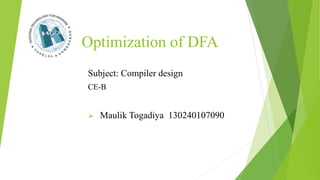
Optimization of DFAs Using Partitioning and Myhill-Nerode Theorem
- 1. Optimization of DFA Subject: Compiler design CE-B Maulik Togadiya 130240107090
- 2. Introduction Minimization/optimization of a deterministic finite automaton refers to the detection of those states of a DFA, whose presence or absence in a DFA does not affect the language accepted by the automata. The states that can be eliminated from automata, without affecting the language accepted by automata, are: ▪Unreachable or inaccessible states. ▪Dead states. ▪Non-distinguishable or indistinguishable state or equivalent states.
- 3. Minimizing DFA’s Lots of methods All involve finding equivalent states: States that go to equivalent states under all inputs
- 4. Minimizing DFA’s by Partitioning Consider the following DFA: Accepting states are yellow Non-accepting states are blue
- 5. S2 and S7 are really the same: Both Final states Both go to S6 under input b Both go to S3 under an a S0 and S5 really the same. We can merge equivalent states into 1 state.
- 6. Partitioning Algorithm First Divide the set of states into Final and Non-final states Partition I Partition II a b S0 S1 S4 S1 S5 S2 S3 S3 S3 S4 S1 S4 S5 S1 S4 S6 S3 S7 *S2 S3 S6 *S7 S3 S6
- 7. Partitioning Algorithm Now See if states in each partition each go to the same partition S1 & S6 are different from the rest of the states in Partition I(but like each other) We will move them to their own partition a b S0 S1 I S4 I S1 S5 I S2 II S3 S3 I S3 I S4 S1 I S4 I S5 S1 I S4 I S6 S3 I S7 II *S2 S3 I S6 I *S7 S3 I S6 I
- 8. Partitioning Algorithm a b S0 S1 S4 S5 S1 S4 S3 S3 S3 S4 S1 S4 S1 S5 S2 S6 S3 S7 *S2 S3 S6 *S7 S3 S6
- 9. Partitioning Algorithm Now again See if states in each partition each go to the same partition In Partition I, S3 goes to a different partition from S0, S5 and S4 We’ll move S3 to its own partition a b S0 S1 III S4 I S5 S1 III S4 I S3 S3 I S3 I S4 S1 III S4 I S1 S5 I S2 II S6 S3 I S7 II *S2 S3 I S6 III *S7 S3 I S6 III
- 10. Partitioning Algorithm Note changes in S6, S2 and S7 a b S0 S1 III S4 I S5 S1 III S4 I S4 S1 III S4 I S3 S3 IV S3 IV S1 S5 I S2 II S6 S3 IV S7 II *S2 S3 IV S6 III *S7 S3 IV S6 III
- 11. Partitioning Algorithm Now S6 goes to a different partition on an a from S1 S6 gets its own partition. We now have 5 partitions Note changes in S2 and S7 a b S0 S1 III S4 I S5 S1 III S4 I S4 S1 III S4 I S3 S3 IV S3 IV S1 S5 I S2 II S6 S3 IV S7 II *S2 S3 IV S6 V *S7 S3 IV S6 V
- 12. Partitioning Algorithm All states within each of the 5 partitions are identical. We might as well call the states I, II III, IV and V. a b S0 S1 III S4 I S5 S1 III S4 I S4 S1 III S4 I S3 S3 IV S3 IV S1 S5 I S2 II S6 S3 IV S7 II *S2 S3 IV S6 V *S7 S3 IV S6 V
- 13. Partitioning Algorithm Here we are a b I III I *II IV V III I II IV IV IV V IV II
- 14. Minimized DFA V a a aa a b b b b b b
- 15. Myphill-Nerode Theorem Step 1 Draw a table for all pairs of states (Qi, Qj) not necessarily connected directly [All are unmarked initially] Step 2 Consider every state pair (Qi, Qj) in the DFA where Qi ∈ F and Qj ∉ F or vice versa and mark them. [Here F is the set of final states]. Step 3 Repeat this step until we cannot mark anymore states − If there is an unmarked pair (Qi, Qj), mark it if the pair {δ(Qi, A), δ (Qi, A)} is marked for some input alphabet. Step 4 Combine all the unmarked pair (Qi, Qj) and make them a single state in the reduced DFA.
- 16. Example Consider the following DFA
- 17. Step 1 − We draw a table for all pair of states.
- 18. Step 2 − We mark the state pairs −
- 19. Step 3 − We will try to mark the state pairs, with green colored check mark, transitively. If we input 1 to state ‘a’ and ‘f’, it will go to state ‘c’ and ‘f’ respectively. (c, f) is already marked, hence we will mark pair (a, f). Now, we input 1 to state ‘b’ and ‘f’; it will go to state ‘d’ and ‘f’ respectively. (d, f) is already marked, hence we will mark pair (b, f).
- 20. After step 3, we have got state combinations {a, b} {c, d} {c, e} {d, e} that are unmarked. We can recombine {c, d} {c, e} {d, e} into {c, d, e} Hence we got two combined states as − {a, b} and {c, d, e} So the final minimized DFA will contain three states {f}, {a, b} and {c, d, e}
